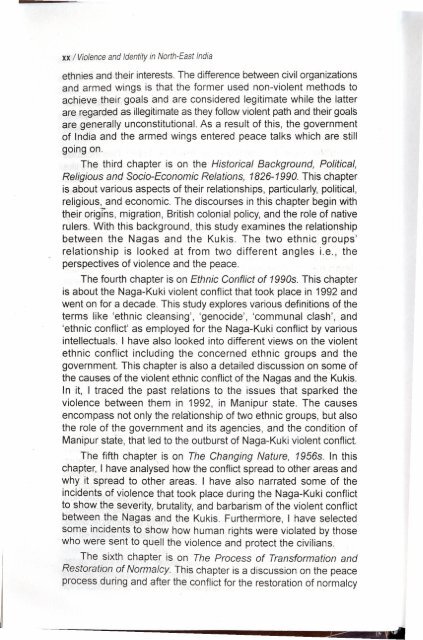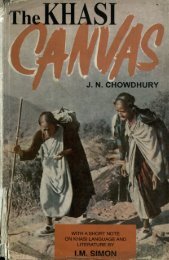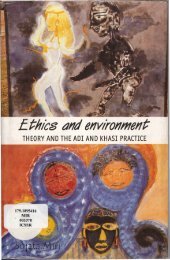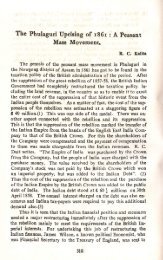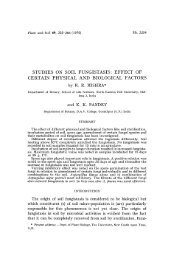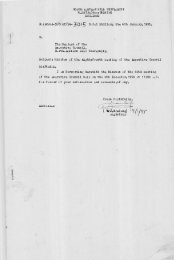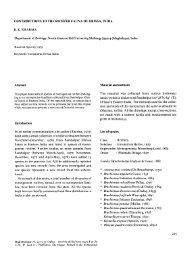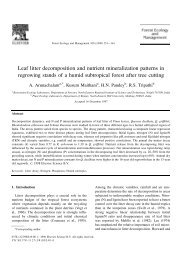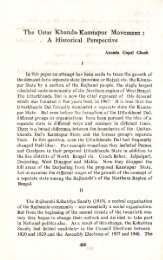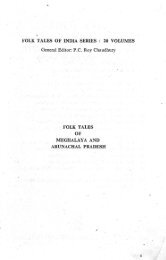Violence n Identity in NE.pdf - DSpace@NEHU
Violence n Identity in NE.pdf - DSpace@NEHU
Violence n Identity in NE.pdf - DSpace@NEHU
Create successful ePaper yourself
Turn your PDF publications into a flip-book with our unique Google optimized e-Paper software.
xx / <strong>Violence</strong> and <strong>Identity</strong> <strong>in</strong> North-East India<br />
ethnies and their <strong>in</strong>terests. The difference between civil organizations<br />
and armed w<strong>in</strong>gs is that the former used non-violent methods to<br />
achieve their goals and are considered legitimate while the latter<br />
are regarded as illegitimate as they follow violent path and their goals<br />
are generally unconstitutional. As a result of this, the government<br />
of India and the armed w<strong>in</strong>gs entered peace talks which are still<br />
go<strong>in</strong>g on.<br />
The third chapter is on the Historical Background, Political,<br />
Religious and Socio-Economic Relations, 1826-1990. This chapter<br />
is about various aspects of their relationships, particularly, political,<br />
religious, and economic. The discourses <strong>in</strong> this chapter beg<strong>in</strong> with<br />
their origms, migration, British colonial policy, and the role of native<br />
rulers. With this background, this study exam<strong>in</strong>es the relationship<br />
between the Nagas and the Kukis. The two ethnic groups'<br />
relationship is looked at from two different angles i.e., the<br />
perspectives of violence and the peace.<br />
The fourth chapter is on Ethnic Conflict of 1990s. This chapter<br />
is about the Naga-Kuki violent conflict that took place <strong>in</strong> 1992 and<br />
went on for a decade. This study explores various def<strong>in</strong>itions of the<br />
terms like 'ethnic cleans<strong>in</strong>g', 'genocide', 'communal clash', and<br />
'ethnic conflict' as employed for the Naga-Kuki conflict by various<br />
<strong>in</strong>tellectuals. I have also looked <strong>in</strong>to different views on the violent<br />
ethnic conflict <strong>in</strong>clud<strong>in</strong>g the concerned ethnic groups and the<br />
government. This chapter is also a detailed discussion on some of<br />
the causes of the violent ethnic conflict of the Nagas and the Kukis.<br />
In it, I traced the past relations to the issues that sparked the<br />
violence between them <strong>in</strong> 1992, <strong>in</strong> Manipur state. The causes<br />
encompass not only the relationship of two ethnic groups, but also<br />
the role of the government and its agencies, and the condition of<br />
Manipur state, that led to the outburst of Naga-Kuki violent conflict.<br />
The fifth chapter is on The Chang<strong>in</strong>g Nature, 1956s. In this<br />
chapter, I have analysed how the conflict spread to other areas and<br />
why it spread to other areas. I have also narrated some of the<br />
<strong>in</strong>cidents of violence that took place dur<strong>in</strong>g the Naga-Kuki conflict<br />
to show the severity, brutality, and barbarism of the violent conflict<br />
between the Nagas and the Kukis. Furthermore, I have selected<br />
some <strong>in</strong>cidents to show how human rights were violated by those<br />
who were sent to quell the violence and protect the civilians.<br />
The sixth chapter is on The Process of Transformation and<br />
Restoration of Normalcy This chapter is a discussion on the peace<br />
process dur<strong>in</strong>g and after the conflict for the restoration of normalcy


